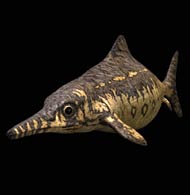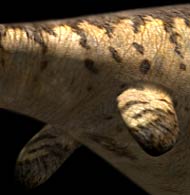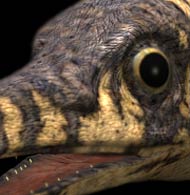
Ophthalmosaurus, one of a group of marine reptiles called ichthyosaurs, had a graceful 5 m long dolphin-shaped body. Its almost toothless jaw was adapted for catching squid and fish. It had the largest eyes of any vertebrate. Fossil evidence shows that its eyeballs were surrounded by a ring of bone, which would have given support against water pressure. This suggests that it hunted in deep dark water.
When ichthyosaur fossils were first excavated during the 1820s, palaeontologists were puzzled by their tailbones, which bent downwards. Ichthyosaurs were reptiles so it was thought that their tails should be straight, like lizards. The mystery was solved when some ichthyosaur fossils were found with impressions of the skin and an outline of a fish-like tail fin. The bent tailbone curved downwards to form the lower half; the upper half was made of cartilage.
Other fossils of adult animals containing the complete skeletons of young have been found. In some, the babies' tails poked out and their heads were still in the mother's belly. These indicate that ichthyosaurs gave birth to live young, who had to emerge tail-first so as not to drown before they could get to the surface to breathe. Modern whales and dolphins do this. More than fifty skeletons of female ichthyosaurs have now been found which contain embryos of unhatched young inside. Numbers of young range from two to eleven, although two or three young at a time seems most usual.
 Ophthalmosaurus, one of a group of marine reptiles called ichthyosaurs, had a graceful 5 m long dolphin-shaped body. Its almost toothless jaw was adapted for catching squid and fish. It had the largest eyes of any vertebrate. Fossil evidence shows that its eyeballs were surrounded by a ring of bone, which would have given support against water pressure. This suggests that it hunted in deep dark water.
Ophthalmosaurus, one of a group of marine reptiles called ichthyosaurs, had a graceful 5 m long dolphin-shaped body. Its almost toothless jaw was adapted for catching squid and fish. It had the largest eyes of any vertebrate. Fossil evidence shows that its eyeballs were surrounded by a ring of bone, which would have given support against water pressure. This suggests that it hunted in deep dark water.


